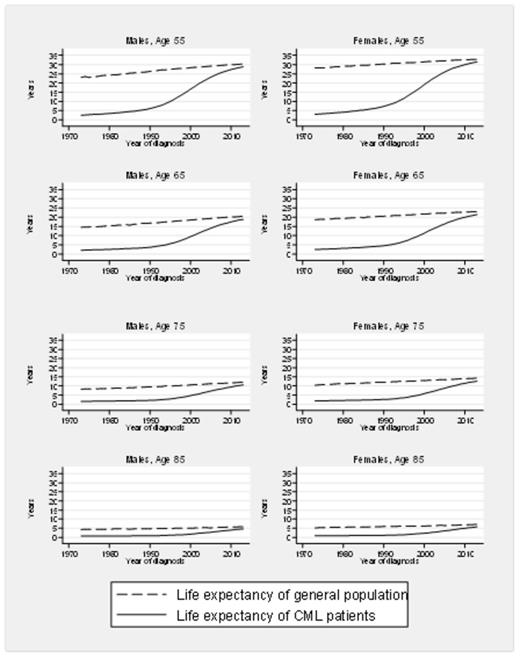Abstract

Background
Chronic Myeloid Leukemia (CML) is a myeloproliferative neoplasm with an incidence of 1-1.5 cases per 100,000 adults, accounting for ∼ 15-20 % of newly diagnosed patients with myeloid leukemia in adults. Treatment for CML has changed dramatically with the introduction of imatinib mesylate (IM), the first tyrosine kinase inhibitor (TKI) targeting the BCR-ABL1 oncoprotein. Previous population-based research (Björkholm et al. JCO, 2011) showed a major improvement in outcome of patients with CML up to 79 years of age diagnosed from 2001 to 2008. The elderly still had poorer outcome, partly because of a limited use of IM. However, increasing recognition of IM resistance and intolerance has led to the development of additional (second and third-generation) TKIs, which have demonstrated effectiveness as salvage therapies or alternative first-line treatments. Here we quantify how the life years lost due to a diagnosis of CML has changed between 1973 and 2013 using a measure called the loss in expectation of life (LEL).
Methods
This population-based study included3,684CML patients diagnosed in Sweden between 1973 and 2013; diagnoses were obtained from the Swedish Cancer Registry. The LEL was estimated using flexible parametric models. The LEL is the difference between the life expectancy in the diseased population and that in a matched subset of the general population. This measure has a simple interpretation as the number of life years lost, or the reduction in the life expectancy, due to a diagnosis of cancer.
Results
The life expectancy increased dramatically between 1990 and 2013 for CML patients of all ages; see figure. Patients in 2013, on average, lose less than 3 life years due to their diagnosis of CML. The largest increase in the life expectancy and thus the largest decrease in LEL over time was seen in younger patients; a diagnosis of CML in 1990 for a male 55-year old, on average, reduced his life expectancy by approximately 20.6 (95% CI: 20.3-21.1) years whereas a diagnosis in 2010 in the same male would on average reduce his life expectancy by only 2.6 (95% CI: 1.4-3.8) years. Although the greatest improvements were seen in those diagnosed at a younger age, those diagnosed at 85 years still benefitted in better survival over year of diagnosis; a diagnosis of CML in 1990 for a 85-year old, on average, reduced his life expectancy by approximately 3.6 (95% CI: 3.5-3.8) years whereas a diagnosis in 2010 in the same male would on average reduce his life expectancy by only 1.6 (95% CI: 1.0-2.2) years.
Conclusions
The reduction in life expectancy, or the number of life years lost due to a diagnosis of CML has greatly reduced over the years Patients who are diagnosed at a younger age lose dramatically fewer years in the most recent calendar years compared to previous years due to their CML diagnosis. Improvements in survival in the late 1990s were at least as great as those from 2001 in the youngest patients. Increased number of allogeneic stem cell transplantations, the introduction of interferon-alpha, improved supportive care and second line treatment with IM have all contributed. Less improvement was seen in the older patients which is probably explained by the relatively slow implementation of IM in this patient group. The impact of second generation TKIs on long-term survival remains to be determined.
Life expectancy of the general population and CML patients aged 55, 65, 75 and 85 years over year of diagnosis, by sex.
Life expectancy of the general population and CML patients aged 55, 65, 75 and 85 years over year of diagnosis, by sex.
No relevant conflicts of interest to declare.
Author notes
Asterisk with author names denotes non-ASH members.

This icon denotes a clinically relevant abstract


This feature is available to Subscribers Only
Sign In or Create an Account Close Modal